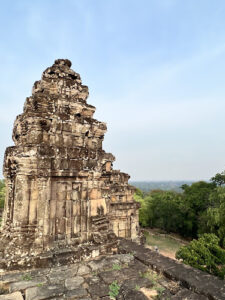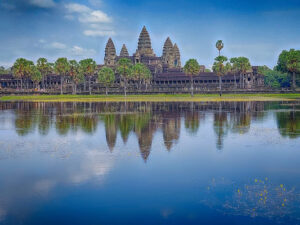
About Bayon Temple
Description
Look, I gotta tell ya - the Bayon Temple isn't just another old pile of rocks. It's absolutely mind-blowing, and I say that as someone who's seen their fair share of temples across Southeast Asia. This 12th-century masterpiece sits right in the heart of Angkor Thom, and it's famous for something totally unique: hundreds of massive stone faces that seem to follow you wherever you go. I remember the first time I rounded a corner and came face-to-face with one of these enigmatic smiles - it literally stopped me in my tracks!Key Features
• The famous face towers - 216 mysteriously smiling faces of Avalokiteshvara carved into 54 towers • Three levels of stunning architecture representing different stages of Buddhist cosmology • Intricate bas-reliefs stretching over a kilometer, showing everyday life in ancient Cambodia • The central tower reaching 45 meters high, symbolizing Mount Meru in Buddhist mythology • Remarkable preservation of detailed carvings depicting historical battles and daily life scenes • The unique mix of Buddhist and Hindu imagery that reflects Cambodia's religious evolution • Original Sanskrit inscriptions still visible on various temple walls • Impressive sunrise and sunset viewing spots around the temple's eastern and western entrancesBest Time to Visit
From my experience, you'll want to hit Bayon Temple either super early in the morning (like, sunrise early) or late afternoon. Trust me on this one - I made the mistake of going at noon once, and boy, was that a sweaty mistake! The best months are November through February when the weather's actually bearable. But here's a pro tip I learned the hard way: avoid December if you can't stand crowds. That's peak tourist season and it can get pretty crazy.How to Get There
Getting to Bayon isn't complicated, but you've got options. Most folks base themselves in Siem Reap and take a tuk-tuk - it's honestly the most fun way to go. You can also hire a car with AC (worth every penny during hot season) or join a guided tour. If you're feeling adventurous like I was, rent a bicycle - just make sure you've got plenty of water and sunscreen! The temple's right in the middle of Angkor Thom, and you can't miss it - just follow the flow of visitors heading toward those giant stone faces.Tips for Visiting
Listen, I've learned a few things from my visits that you might find helpful. First off, wear proper shoes - those ancient stones can be slippery and uneven. Bring a flashlight if you're planning on exploring the darker corridors (your phone light works too, but trust me, a real flashlight is better). And whatever you do, don't forget your camera - the lighting during early morning is absolutely fantastic for capturing those mysterious smiles. Take your time exploring the bas-reliefs - they tell amazing stories if you look closely. I spent hours just walking around, finding new details I missed the first time. Oh, and bring some small bills for water vendors - you'll definitely need hydration while exploring. Dress respectfully - this is still an active religious site. Ladies, cover your shoulders and knees. And here's something most guides won't tell you: the best photos aren't from the obvious spots where everyone clusters. Walk around to the back of the temple, where fewer tourists go. You'll find some incredible angles and might even have the place to yourself for a few precious moments. Remember to pace yourself - there's a lot to take in, and the humid Cambodian climate can be brutal if you're not used to it. I usually recommend spending at least 2-3 hours here to really appreciate all the details and soak in the atmosphere. And yeah, those faces really do seem to follow you everywhere - it's not just your imagination!Description
Look, I gotta tell ya – the Bayon Temple isn’t just another old pile of rocks. It’s absolutely mind-blowing, and I say that as someone who’s seen their fair share of temples across Southeast Asia. This 12th-century masterpiece sits right in the heart of Angkor Thom, and it’s famous for something totally unique: hundreds of massive stone faces that seem to follow you wherever you go. I remember the first time I rounded a corner and came face-to-face with one of these enigmatic smiles – it literally stopped me in my tracks!
Key Features
• The famous face towers – 216 mysteriously smiling faces of Avalokiteshvara carved into 54 towers
• Three levels of stunning architecture representing different stages of Buddhist cosmology
• Intricate bas-reliefs stretching over a kilometer, showing everyday life in ancient Cambodia
• The central tower reaching 45 meters high, symbolizing Mount Meru in Buddhist mythology
• Remarkable preservation of detailed carvings depicting historical battles and daily life scenes
• The unique mix of Buddhist and Hindu imagery that reflects Cambodia’s religious evolution
• Original Sanskrit inscriptions still visible on various temple walls
• Impressive sunrise and sunset viewing spots around the temple’s eastern and western entrances
Best Time to Visit
From my experience, you’ll want to hit Bayon Temple either super early in the morning (like, sunrise early) or late afternoon. Trust me on this one – I made the mistake of going at noon once, and boy, was that a sweaty mistake! The best months are November through February when the weather’s actually bearable. But here’s a pro tip I learned the hard way: avoid December if you can’t stand crowds. That’s peak tourist season and it can get pretty crazy.
How to Get There
Getting to Bayon isn’t complicated, but you’ve got options. Most folks base themselves in Siem Reap and take a tuk-tuk – it’s honestly the most fun way to go. You can also hire a car with AC (worth every penny during hot season) or join a guided tour. If you’re feeling adventurous like I was, rent a bicycle – just make sure you’ve got plenty of water and sunscreen! The temple’s right in the middle of Angkor Thom, and you can’t miss it – just follow the flow of visitors heading toward those giant stone faces.
Tips for Visiting
Listen, I’ve learned a few things from my visits that you might find helpful. First off, wear proper shoes – those ancient stones can be slippery and uneven. Bring a flashlight if you’re planning on exploring the darker corridors (your phone light works too, but trust me, a real flashlight is better). And whatever you do, don’t forget your camera – the lighting during early morning is absolutely fantastic for capturing those mysterious smiles.
Take your time exploring the bas-reliefs – they tell amazing stories if you look closely. I spent hours just walking around, finding new details I missed the first time. Oh, and bring some small bills for water vendors – you’ll definitely need hydration while exploring.
Dress respectfully – this is still an active religious site. Ladies, cover your shoulders and knees. And here’s something most guides won’t tell you: the best photos aren’t from the obvious spots where everyone clusters. Walk around to the back of the temple, where fewer tourists go. You’ll find some incredible angles and might even have the place to yourself for a few precious moments.
Remember to pace yourself – there’s a lot to take in, and the humid Cambodian climate can be brutal if you’re not used to it. I usually recommend spending at least 2-3 hours here to really appreciate all the details and soak in the atmosphere. And yeah, those faces really do seem to follow you everywhere – it’s not just your imagination!
Location
Places to Stay Near Bayon Temple
Find Tours in Krong Siem Reap
Explore More Travel Guides
No reviews found! Be the first to review!


